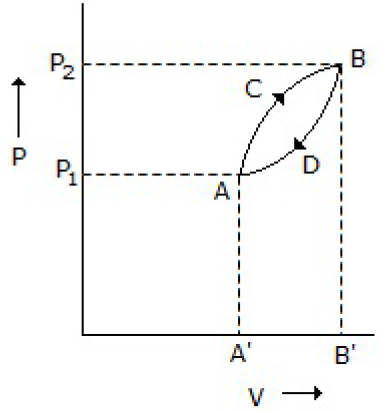The equation DU = Tds - PdV is applicable to infinitesimal changes occuring in
An open system of constant composition
A closed system of constant composition
An open system with changes in composition
A closed system with changes in composition
Correct Answer :
D. A closed system with changes in composition
Related Questions
The absolute entropy for all crystalline substances at absolute zero temperature is
Zero
Negative
More than zero
Indeterminate
For a cyclic process, a fixed ratio between heat and work
Always exists
May exist
Never exists
Is difficult to predict
An isentropic process is carried out at constant
Volume
Pressure
Temperature
All (A), (B) and (C)
A thermodynamic system is taken from state A to B along ACB and is brought back to A along BDA as shown below in the P-V diagram. The net work done during the complete cycle is given by the area covered by

P1ACBP2P1
ACBB1A1A
ACBDA
ADBB1A1A
Normal temperature and pressure (N.T.P.) corresponds to
0°C and 760 mm Hg
15°C and 760 mm Hg
20°C and 760 mm Hg
0°C and 1 kgf/cm2
Fugacity of a component in an ideal gas mixture is equal to the partial pressure of that component in the mixture. The fugacity of each component in a stable homogeneous solution at constant pressure and temperature __________ as its mole fraction increases.
Decreases
Decreases exponentially
Increases
Remain constant
There is a change in __________ during the phase transition.
Volume
Pressure
Temperature
All a, b & c
The equation Tds = dE - PdV applies to
Single phase fluid of varying composition
Single phase fluid of constant composition
Open as well as closed systems
Both (B) and (C)
The temperature at which a real gas obeys the ideal gas laws over a wide range of pressure is called the __________ temperature.
Critical
Boyle
Inversion
Reduced
In case of a reversible process (following pvn = constant), work obtained for trebling the volume (v1 = 1 m3 and v23 m3) is maximum, when the value of 'n' is
0
1
y = 1.44
1.66
When liquid and vapour phases of one component system are in equilibrium (at a given temperature and pressure), the molar free energy is
More in vapour phase
More in liquid phase
Same in both the phases
Replaced by chemical potential which is more in vapour phase
When pressure is applied on the system, ice ↔ water, then
Equilibrium cannot be established
More ice will be formed
More water will be formed
Evaporation of water will take place
The internal energy of an ideal gas is a function of its __________ only.
Molecular size
Volume
Pressure
Temperature
The third law of thermodynamics states that the
Heat capacity of a crystalline solid is zero at absolute zero temperature
Heat transfer from low temperature to high temperature source is not possible without external work
Gases having same reduced properties behaves similarly
None of these
For water at 300°C, it has a vapour pressure 8592.7 kPa and fugacity 6738.9 kPa Under these conditions, one mole of water in liquid phase has a volume of 25.28 cm3 and that in vapour phase in 391.1 cm3.Fugacity of water (in kPa) at 9000 kPa will be
6738.9
6753.5
7058.3
9000
Which one is true for a throttling process?
A gas may have more than one inversion temperatures
The inversion temperature is different for different gases
The inversion temperature is same for all gases
The inversion temperature is the temperature at which Joule-Thomson co-efficient is infinity
If an ideal solution is formed by mixing two pure liquids in any proportion, then the __________ of mixing is zero
Enthalpy
Volume
Both 'a' & 'b'
Neither 'a' nor 'b'
The amount of heat required to decompose a compound into its elements is __________ the heat of formation of that compound from its elements.
Less than
More than
Same as
Not related to
What is the value of Joule-Thomson co-efficient for an ideal gas?
+ve
-ve
0
∞
All gases except __________ shows a cooling effect during throttling process at atmospheric temperature and pressure.
Oxygen
Nitrogen
Air
Hydrogen
The shape of T-S diagram for Carnot Cycle is a
Rectangle
Rhombus
Trapezoid
Circle
Entropy of the system decreases, when
Snow melts into water
A gas expands spontaneously from high pressure to low pressure
Water is converted into ice
Both (B) & (C)
For a constant volume process
dE = CpdT
dE = CvdT
dQ = dE + pdV
dW = pdV
The expression, nRT ln(P1/P2), is for the __________of an ideal gas.
Compressibility
Work done under adiabatic condition
Work done under isothermal condition
Co-efficient of thermal expansion
Thermal efficiency of a Carnot engine can approach 100%, only when the temperature of the
Cold reservoir approaches zero
Hot reservoir approaches infinity
Either (A) or (B)
Neither (A) nor (B)
The ammonia synthesis reaction represented by N2 + 3H2 2NH3; ΔH = - 22.4 kcal, is
Endothermic
Exothermic
Isothermal
Adiabatic
Which of the following is an undesirable characteristic of a refrigerant?
It should be non-explosive
It should have a sub-atmospheric vapor pressure at the temperature in refrigerator coils
Its vapor pressure at the condenser temperature should be very high
None of these
If the internal energy of an ideal gas decreases by the same amount as the work done by the system, then the
Process must be isobaric
Temperature must decrease
Process must be adiabatic
Both (B) and (C)
Compressibility factor (i.e., the ratio of actual volume of gas to the volume predicted by ideal gas law) for all gases are
Always greater than one
Same at the same reduced temperature
Same at the same reduced pressure
Both (B) & (C)
The efficiency of a Carnot heat engine operating between absolute temperatures T1 and T2 (when, T1 > T2) is given by (T1 - T2)/T1. The co-efficient of performance (C.O.P.) of a Carnot heat pump operating between T1 and T2 is given by
T1/(T1-T2)
T2/(T1-T2)
T1/T2
T2/R1
